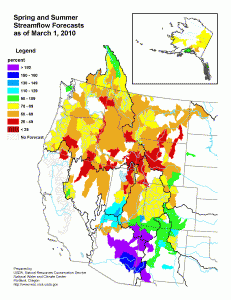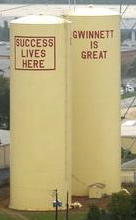The week that was 3/7-13/2010
Posted on | March 14, 2010 | 2 Comments

“Late at night when you’re doing graffiti with the river’s sound, the freeways and with a full moon, you could look down at all the broken bottles and see a diamond-studded highway.” — Charles “Chaz” Bojórquez, one of the artists in the Pasadena Museum of California Art’s exhibit “The Ulysses Guide to the Los Angeles River,” “LA River Runs through it,” Wall Street Journal, March 10, 2010
 Federal prosecutors this afternoon filed a criminal complaint that charges a Santa Monica sushi restaurant and one its chefs with selling Sei whale meat. — Press release, National Oceanic and Atmospheric Administration, March 10, 2010
Federal prosecutors this afternoon filed a criminal complaint that charges a Santa Monica sushi restaurant and one its chefs with selling Sei whale meat. — Press release, National Oceanic and Atmospheric Administration, March 10, 2010
A pair of running shoes? 1,247 gallons. — “How to size up a ‘water footprint’,” Los Angeles Times, March 13, 2010
“We want to be sure that people have access to the same liquids they had previously.” — John Barten, natural resources director for Three Rivers Park District, “Three Rivers wants to can the plastic,” Minneapolis Star Tribune, March 10, 2010

Source: USDA Natural Resources Conservation Service. Click on the image to be taken to the US Drought Monitor
“Our population is in the south and most of our water is in the north… ” — Bob Sandford, chairman of the Canadian Partnership Initiative in Support of the United Nations’ Water for Life Decade, “Facing Canada’s water woes,” National Post, March 9, 2010
“I believe the issue is, ‘Can you provide water to Region C and at the same time do the least amount of hurt to the people of Region D?'” — Richard LeTourneau, chairman of the Northeast Texas Region D Water Planning Group, “Question mark hangs over area’s water future,” Longview News-Journal, March 12, 2010
… river basins in eastern Washington, Idaho, Wyoming and Montana are below 50 percent of their average seasonal snowpack for this time of year… — “Water shortages may hit northern Rockies,” USA Today, March 11, 2010
… irrigators in the Central Valley Project have … enjoyed the equivalent of a 60-year, interest-free loan. They have so far repaid about 19% of their $1.2-billion share of the federal project’s capital costs. And under reclamation law, the government charges them no interest. — “Another water project could divide the state,” Los Angeles Times, March 9, 2010

“My grandfather moved here in 1906 and did dryland farming until we got our first well in ’62. We’re just not very good at dryland anymore.” — Potato farmer Orman Johnson, “Columbia Basin farmers rejoice but some environmentalists worry over plans for a key irrigation pipeline,” Seattle Times, March 13, 2010
“We want to know what did they know about the water, when did they know and what did they do about it.” — Congressman Brad Miller (D-NC), “Lejune water probe: did Marine Corps hide benzene data?” McClatchy, March 9, 2010
“When acceptable arsenic levels went from 50 parts per billion to 10 parts, it put 29 systems out of compliance.” — John Camden, Montana Rural Water Systems, “Rising expectations for water leaves towns tapped out,” Billings Gazette, March 9, 2010
“For the amount of money these guys are saying it’s going to cost to comply with numeric nutrient limits, you could buy a gold-plated toilet for every home and trailer in the state.” — Earthjustice attorney David Guest, “State, EPA battle over cleaning up polluted waters,” The Tampa Tribune, March 12, 2010
“… environmental regulations are not free, but the money that’s spent is an investment in our country – and one that pays for itself.” — US Environmental Protection Agency Administrator Lisa Jackson, “Mountaintop removal guidelines coming soon,” The Charleston Gazette, March 8, 2010
 Originally, the twin towers proclaimed “Growing Gwinnett.” When a vandal’s bullet damaged one tank in 1977, officials changed the slogan to “Gwinnett is Great.” At one point, Coca-Cola expressed interest in painting the tanks to look like Coke cans, but nothing changed until the county repainted the towers in 2001. Officials then adopted “Success Lives Here” for one of the tanks. — “Gwinnett water towers’ days appear numbered,” Atlanta Journal-Constitution, March 11, 2010
Originally, the twin towers proclaimed “Growing Gwinnett.” When a vandal’s bullet damaged one tank in 1977, officials changed the slogan to “Gwinnett is Great.” At one point, Coca-Cola expressed interest in painting the tanks to look like Coke cans, but nothing changed until the county repainted the towers in 2001. Officials then adopted “Success Lives Here” for one of the tanks. — “Gwinnett water towers’ days appear numbered,” Atlanta Journal-Constitution, March 11, 2010
“This is my question for conservatives: Don’t you want to live too?” — Bill Maher on climate change skeptics, “Real Time with Bill Maher,” March 12, 2010
 “There is a direct link between inflows, salinity, crabs and cranes.” — Tom Stehn, whooping crane coordinator, Aransas National Wildlife Refuge, “Group sues state over whooping crane deaths,” San Antonio Express-News, March 12, 2010
“There is a direct link between inflows, salinity, crabs and cranes.” — Tom Stehn, whooping crane coordinator, Aransas National Wildlife Refuge, “Group sues state over whooping crane deaths,” San Antonio Express-News, March 12, 2010
“Everybody who lives in Southern Nevada knows how big the water problem is. And if they don’t they should.” — M Resort Chief Executive Officer Anthony Marnell III, “Lawsuits filed to block state from taking water funds,” Las Vegas Review-Journal, March 12, 2010
A member of the board of directors of Southern California’s largest water wholesaler is the first person appointed to a new agency in charge of the Delta ecosystem and water. — “Southern California water company official appointed to new Delta water agency,” Contra Costa Times, March 9, 2010
I will be on assignment for the foreseeable future. ‘The week that was’ will return as time allows. To all of its regular readers, thank you. For full round-ups every day of California water news, go to Aquafornia or for the sharpest eye on the world of water, go to Michael Campana’s WaterWired. -Emily Green
Comments
2 Responses to “The week that was 3/7-13/2010”
Leave a Reply



March 14th, 2010 @ 12:11 pm
Thanks for watching the water news so closely, Emily, and for having shared all these (noteworthy, provocative, disappointing, inspiring, etc) clips every week!
March 14th, 2010 @ 6:22 pm
I hadn’t realized how much this had become part of my Sunday routine until right now! Thanks for sharing these past months, your sharp wit and keen observations will be missed!